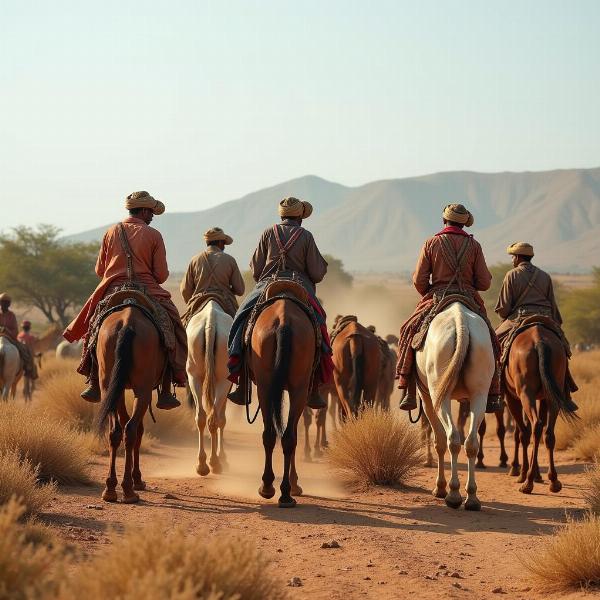Nomadic pastoralists meaning in Hindi revolves around the terms “khanabadosh charwahe” (ख़ानाबदोश चरवाहे) or “ghumantu pashupalak” (घुमंतू पशुपालक). These terms encapsulate the essence of communities who move from place to place, herding their livestock and adapting to various environments. Understanding the meaning and implications of this lifestyle provides valuable insight into a significant part of Indian history and culture.
Understanding the Term “Nomadic Pastoralists”
What exactly does it mean to be a nomadic pastoralist? It’s a way of life centered around raising livestock and moving from one area to another in search of fresh grazing land and water. These communities don’t have a fixed settlement, their lives are a continuous journey dictated by the needs of their animals and the changing seasons. They are deeply connected to their livestock, which provides them with sustenance, livelihood, and a strong sense of cultural identity.
 Nomadic Pastoralists in India
Nomadic Pastoralists in India
The Significance of Nomadic Pastoralism in India
Nomadic pastoralism has a long and rich history in India, playing a vital role in shaping the country’s diverse cultural tapestry. These communities have contributed significantly to the economy, especially in arid and semi-arid regions where agriculture is challenging. They have developed unique knowledge systems regarding animal husbandry, environmental adaptation, and traditional medicine. Their movements across vast landscapes have also facilitated trade and cultural exchange between different regions.
Nomadic Pastoralist Communities in India
Several nomadic communities across India practice pastoralism. The Rabaris of Gujarat and Rajasthan, the Gaddis of Himachal Pradesh, and the Bakarwals of Jammu and Kashmir are a few examples. Each community has its own distinct traditions, languages, and social structures, showcasing the incredible diversity within nomadic pastoralism.
Challenges Faced by Nomadic Pastoralists
Despite their resilience and adaptability, nomadic pastoralists face numerous challenges in the modern era. Shrinking grazing lands due to urbanization and agricultural expansion, limited access to essential services like healthcare and education, and social marginalization are some of the significant issues they encounter. Climate change also poses a severe threat, impacting water availability and grazing patterns.
Addressing the Challenges
Efforts are being made to support nomadic pastoralist communities and ensure their sustainable livelihoods. Government policies focused on providing access to resources, education, and healthcare are crucial. Promoting sustainable grazing practices and recognizing their traditional land rights are also vital for their well-being.
The Future of Nomadic Pastoralism
The future of nomadic pastoralism hinges on balancing their traditional lifestyle with the demands of a rapidly changing world. Preserving their cultural heritage while ensuring access to modern amenities is a complex challenge. Supporting their adaptation strategies and empowering them to participate in decision-making processes is essential for their continued existence.
Conclusion
Nomadic pastoralists, known as “khanabadosh charwahe” (ख़ानाबदोश चरवाहे) or “ghumantu pashupalak” (घुमंतू पशुपालक) in Hindi, represent a unique and integral part of Indian culture and history. Their traditional way of life, centered around livestock and mobility, faces numerous challenges in the modern era. Protecting their rights, supporting their livelihoods, and preserving their rich cultural heritage is essential for their survival and the preservation of a vital part of India’s cultural diversity.
FAQ
- What is the primary occupation of nomadic pastoralists? Raising and herding livestock.
- Why do nomadic pastoralists move from place to place? To find fresh grazing land and water for their animals.
- What are some of the challenges faced by nomadic pastoralists in India? Shrinking grazing lands, limited access to essential services, and social marginalization.
- How can we support nomadic pastoralist communities? By providing access to resources, education, healthcare, and recognizing their traditional land rights.
- What is the Hindi term for nomadic pastoralists? “Khanabadosh charwahe” (ख़ानाबदोश चरवाहे) or “ghumantu pashupalak” (घुमंतू पशुपालक).
Meaning-Hindi.in offers comprehensive translation services specializing in various fields, including business and commercial documents, legal and certified translations, technical manuals, website localization, and educational materials. Our expertise in Hindi and Indian culture ensures accurate and culturally sensitive translations for all your needs. Contact us today for professional translation services: Email: [email protected], Phone: +91 11-4502-7584. Meaning-Hindi.in is your trusted partner for all your Hindi translation requirements.